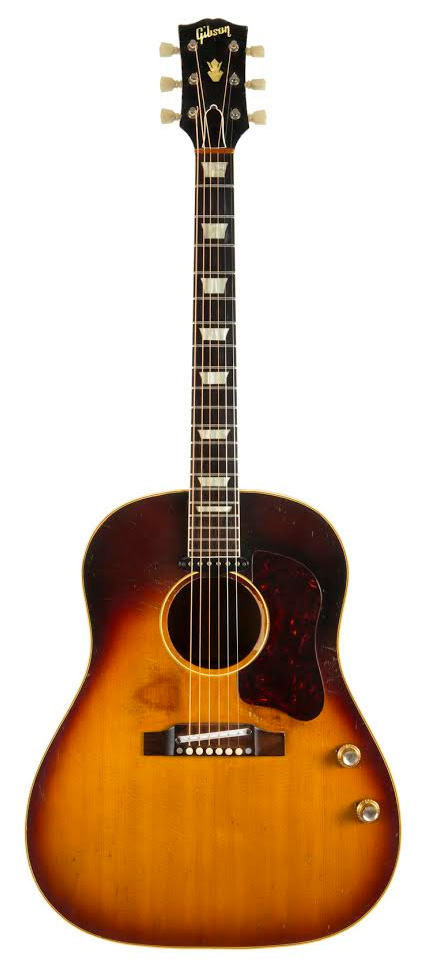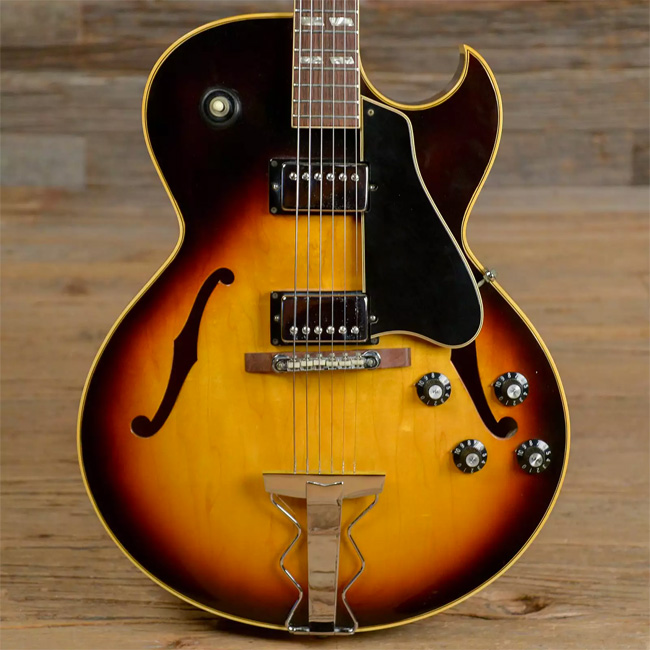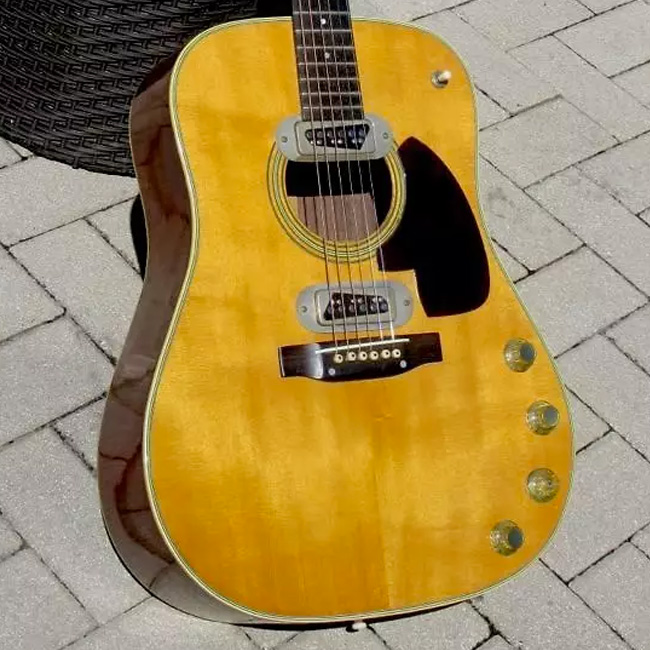This piece has been adapted from the author's critically acclaimed book, Beatles Gear – All The Fab Four’s Instruments From Stage To Studio. To check out the complete work, see our links at the end of the article.
It was a Christmas set at Finsbury Park in 1963 when the guitar went missing.
The guitar in question - a Gibson J-160E - happened to belong to John Lennon, the most iconic member of the world’s most popular music group. It was the guitar on which Lennon wrote (with Paul McCartney) and performed songs like “She Loves You,” “I Want to Hold Your Hand,” “Please, Please, Me,” “All My Loving,” “From Me to You,” and “This Boy,” among others. A sacred artifact of pop and rock ‘n’ roll history, lost forever.
Or so it seemed. After surfacing again over fifty years later, it sold in November 2015 for a staggering $2.41 million dollars at Julien’s Auctions Icons & Idols Rock n’ Roll Auction, making it the most expensive guitar sold in a single private transaction to date.
This is its story.
Two Gibson J-160Es, Please

John Lennon's Gibson J-160E
It starts in England when the Beatles returned to Liverpool from their September 4, 1962 studio session. Earlier in the year, just after Abbey Road staff had complained about the poor state of much of the group’s gear, Lennon and Harrison had ordered a pair of new Gibson electric-acoustic J-160E guitars. Just after they returned, they received word that the guitars had arrived.
Gibson launched the J-160E in 1954. An unusual hybrid, it looked like a regular flat-top acoustic, but was fitted with an electric guitar-type pickup and controls. It could be used unplugged as a regular acoustic guitar for songwriting on the road, for example, or plugged in to give an amplified approximation of an acoustic guitar whether on stage or in the studio.
Lennon and Harrison’s Gibson J-160Es were identical sunburst finish guitars, each with a 16-inch round-shouldered body. They were built with mahogany backs and sides and three-ply laminated spruce tops with internal ladder bracing. The necks were made of mahogany, too, with bound rosewood fingerboards inlaid with crown-shaped pearl markers, keystone-tip Kluson tuners, tortoise-shell pickguards, and an adjustable ceramic saddle mounted in rosewood bridge bases.
Each of the guitars was fitted with one Gibson P-90 single-coil pickup between the end of the neck and the soundhole, with a single volume and tone control mounted on the body’s lower face and an output jack on the side. The guitars arrived in brown Lifton cases with pink-lined interiors.
The Beatles ordered the J-160Es from Rushworth’s, one of the few shops in Liverpool where musicians could buy American-made instruments. The J-160E was not one of the Gibson models generally on sale in the UK through distributor Selmer, so Lennon and Harrison had to order the guitars from a catalogue and wait for them to be sent specially to the store from the United States.
The total credit price noted for Lennon’s Gibson J-160E (and presumably Harrison’s, too) was a cool £161/1/- (£161.05 was about $450 then and is around £3,100 or $4,600 today). The receipt also reveals that Epstein paid for the guitar in full almost exactly a year later.
But Why a Gibson J-160E?
Tony Sheridan, a UK performer that The Beatles played many shows with during their long stays in Hamburg, Germany, may have influenced the two guitarists in their choice of this unusual model.
“At the time, everybody was using a cricket bat,” Sheridan says, “a piece of wood with strings on it. Not too many people were into big jazz guitars, but I was. So I guess it rubbed off on the Liverpool crowd.”
Sheridan believes that Lennon and Harrison intended to order the archtop Gibson ES-175 – the model he had used in Hamburg and that the two Beatle guitarists had tried – but that they somehow ended up with the flattop J-160E by mistake. He says that they had enjoyed using his Gibson ES-175 and would refer to it as “the jumbo.”
Maybe Sheridan is right. Maybe when Lennon and Harrison went into Rushworth’s to order their guitars, they asked for “the Gibson electric jumbo,” and this is what they got. Early '60s Gibson catalogues list the J-160E as the “Electric Jumbo Model” – hence the J and the E – while the ES-175 is listed as the “Electric Spanish Model.”

1968 Gibson ES-175

1963 Martin D-28E
Sheridan also points to a more attractive second theory. Perhaps the guys were attracted to the pickup-equipped Martin D-28E that he also used in Hamburg, an instrument that is much closer in style to the J-160E.
“Love Me Do” and “PS I Love You”
The serial number on Lennon's guitar is 73157, listed on the same page of Gibson’s shipping records as Harrison’s 73161. Both guitars were shipped from Gibson on the same day, June 27, 1962.
They may have been sent by sea from the USA, which would account for the guitars taking more than two months to arrive. Rushworth’s boasted in Mersey Beat that the guitars were “specially flown to England by jet from America,” but that was probably just part of the promotional hype.
That receipt for Lennon’s Gibson is dated September 10. He and Harrison were never pictured with the J-160Es prior to that date. This seems to rule out the Gibsons from the first two recording sessions for “Love Me Do,” with Best on June 6 and with Starr on September 4.
To complicate matters further, the presentation of the guitars to the group at Rushworth’s may not have happened on September 10. In the photographs taken of the event, the guitars already have smudges on the finish, as if they had been well played. Both guitars have string tied around the headstock for a shoulder strap, which would not have been how they were shipped from Gibson.
Perhaps the photo session was staged later, an afterthought by Epstein and Rushworth’s with an eye to a promotional opportunity? Bill Harry, publisher of Mersey Beat, remembers that the event was set up specifically for his paper, to help promote the group and the music store. The pictures did not appear in Mersey Beat until October.
On September 11, the day after Rushworth’s sold them their new guitars, the Beatles once again visited EMI’s Abbey Road Studio 2 in London to try again to record their first single. The group once again recorded “Love Me Do” and “PS I Love You.” All three versions – June 6, September 4, September 11 – have since been released and all bear a similar guitar sound. So maybe the same guitar was used for all three sessions – meaning either Lennon’s Rickenbacker or Harrison’s Duo Jet.
It is, of course, possible that the J-160Es were used for the recording on the 11th. When Lennon and Harrison first used their Gibson J-160Es in the studio, they recorded them by plugging the guitars into their amplifiers. The guitars were not recorded acoustically but with a miked-up amplifier. If one plays a J-160E, a Rickenbacker 325, or a Gretsch Duo Jet today through an Vox AC30, it’s relatively easy to get the same sound quality from all three guitars, very clean and full.
Please Please Me
The Helen Shapiro package tour started on Saturday, February 2. During the tour, Epstein managed to fill the Beatles’ days off with sporadic shows at the Cavern and a full schedule of live radio and television appearances to help promote the new single.
Amid all this work, producer George Martin and Epstein managed to book another recording session at EMI. On Monday, February 11, The Beatles entered Abbey Road Studio 2 and recorded their first full-length LP, the 14-track Please Please Me. The whole album was recorded in one grueling day.
The session was recorded on a two-track tape machine, almost entirely live with few or no overdubs. By today's standards, this is an incredible achievement. The instruments and amplification that the group used for making Please Please Me were the same as for their live performances during the Shapiro tour: the ’58 Rickenbacker 325, Gretsch Duo Jet, both Gibson J-160Es, both Vox AC30 Twin amps (without Top Boost), and the Hofner bass played through the studio’s Leak power amp and a Tannoy 15-inch speaker cabinet. Ringo played his Premier drum set.
By February 22, the band’s second single, “Please Please Me,” neared the top of the British charts. Epstein’s program of never-ending promotion had paid off perfectly. On February 17, The Beatles had recorded a performance for the influential British television show Thank Your Lucky Stars, miming a performance of the hit 45. McCartney played his Hofner bass, Harrison and Lennon both used their Gibson J-160E acoustic-electric guitars, and Starr played his Premier drum set with the new bug Beatles logo displayed on the front drumhead.
By mid-1963, it must have seemed that the group’s success was providing its own momentum. On Monday July 1, they were again summoned to Studio 2 at EMI’s recording base in Abbey Road for another recording session, where they recorded their fourth single, “She Loves You” backed with “I’ll Get You.” Photographs from the session show Starr playing his Ludwig drum set and Lennon with his Gibson J-160E plugged into his Vox AC30. McCartney played his Hofner.
The Beatles Autumn Tour
By the beginning of November, the group had started their fourth package tour. But this time, they were the headliners. Billed as The Beatles Autumn Tour, the month-and-a-half round of English theatres (plus a gig each in Dublin and Belfast) featured an almost daily ritual of live shows. A mix of radio and television interviews and performances were fitted into the schedule wherever possible.
The equipment they used on the Autumn Tour saw little change. Starr played his Ludwig drum set. Lennon played his Rickenbacker 325 as his main guitar and the Gibson J-160E when required through his ’63 Vox AC30. McCartney used his new ’63 Hofner bass with his original ’61 as a spare, each played through the AC30 head and T60 bass cabinet. Harrison played his Gretsch Country Gentleman through his ’63 AC30.
On November 22, the group’s second LP, With The Beatles, was released in the UK on Parlophone (PMC 1206 mono, PCS 3045 stereo) with advance orders of 300,000 copies. The album featured “It Won’t Be Long,” “All I’ve Got To Do,” “All My Loving,” “Don’t Bother Me,” “Little Child,” “Till There Was You,” and “Please Mister Postman” on Side A.
Side B featured “Roll Over Beethoven,” “Hold Me Tight,” “You Really Got A Hold On Me,” “I Wanna Be Your Man,” “Devil In Her Heart,” “Not A Second Time,” and “Money.”
A week later, on November 29, the single "I Want To Hold Your Hand" backed with "This Boy" came out on Parlophone (R 5084), with over one million advance orders. The Beatles had conquered Britain.
During the tour, they made an appearance on the Granada television program Scene, taping a performance of “I Want To Hold Your Hand” and “This Boy” on November 25. The television studio’s stage was set up with large headlines from a fictitious Daily Echo newspaper and a drum riser made to look like a camera lens. When they mimed “This Boy,” Harrison and Lennon both used their Gibson J-160E guitars – one of the last occasions that Lennon would be filmed with his.
Lennon's J-160E Goes Missing
John noticed his acoustic was nowhere to be found at the Christmas shows in London in 1963. An account of the Gibson’s abduction published a couple of years later in The Beatles Monthly Book describes the ordeal:
“By the time of the Finsbury Park show, the total collection of Beatle guitars had grown, but John and Paul were still using their Gibson jumbos in the dressing room. They were there as stand-by replacements if strings snapped during a performance. John recalls, "George and I often took a jumbo home with us, so nobody noticed until the end of the season that one was missing. A week or two afterwards I asked Mal [Evans] where he’d put my jumbo. It was only then that we realised the guitar had been pinched, at Finsbury Park. No, I never got it back.”
Mal Evans, the group’s roadie, also recalled the grim moment, “The worst of all was at the Finsbury Empire in London, when I lost John’s guitar. It was one he’d had for years, as well. It just disappeared. ‘Where’s my jumbo?’ he said. I didn’t know. It’s still a mystery.”
At some point between September 1962, when they acquired their Gibsons, and December 1963, Lennon and Harrison had in fact swapped their guitars. Perhaps it was because of playability or sound preference. Or maybe, because the instruments were identical, the guitars were unknowingly switched, and neither Lennon nor Harrison noticed … or cared.
So Lennon’s Gibson guitar, serial number 73157, that went missing in 1963 was actually the one that had been registered to Harrison under the hire-purchase deal made at Rushworth’s music shop. And the J-160E guitar that Harrison still owned decades later, serial number 73161, was the guitar that was logged to Lennon on the original hire-purchase document.

Andy Babiuk with Lennon's Gibson J-160E
A Lost Icon Rediscovered
As the author of the definitive book on group's gear, Beatles Gear – All The Fab Four’s Instruments From Stage To Studio, people often contact me at my guitar shop in Rochester, New York thinking that they have an instrument owned by the Beatles. It’s generally nothing, but something felt different when John McCaw’s close friend and guitar instructor Marc Intravaia contacted me.
As John related: “In April 2014 I was leaving my guitar group’s weekly jam and noticed a magazine from May 2012 in the studio’s bookcase. It featured a cover story titled ‘The George Harrison Collection.’ There was a photo and bio of the J-160E, which bore many similarities to mine. I saw identical marks in the same location on both guitars. Reading on, the story noted that the two Beatles swapped guitars in 1963 for reasons unknown."
"My heart skipped a beat, and the journey began. We searched for the person who could help us confirm the identity of my guitar.” This led John and Marc to me.
McCaw brought his used J-160E for me to inspect it. He bought the guitar in the late ‘60s from a friend in southern California after returning from military service in Vietnam. After examining McCaw’s guitar, I was able to match the wood grain in the spruce top to photos of Lennon playing the guitar with the Beatles in the early '60s.
The guitar has never been modified in any way – no hardware or electronics changes, no refinishing. In viewing 1963 videos of “I Want to Hold Your Hand” and “This Boy,” marks on the guitar further confirmed its identity.
Wood grain is like a fingerprint. No two are the same. Without a doubt, this was a match. After 50 years, John Lennon’s beloved Gibson J-160E was finally found.
Given the historical significance and history of the guitar, we knew it could fetch a huge sum at auction. In November 2015 it sold at Julien's for a record $2.41 million, a record that is yet to be broken as of the writing of this article. A percentage of proceeds from the sale of the guitar went to Spirit Foundations, Inc., a non-profit organization founded by John and Yoko.
About the Author:
Andy Babiuk is the author of the definitive books Beatles Gear, Rolling Stones Gear, and The Story of Paul Bigsby. He is also the owner of Andy Babiuk's Fab Gear music shop in Rochester, NY. Explore his shop on Reverb or see more about his books below.
Visit Andy Babiuk's Fab Gear Shop on ReverbGibson J-160E

